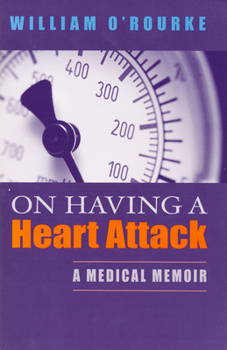On Having a Heart Attack: A Medical Memoir
Select Format
Select Condition 
Book Overview
"As I walked away with my refreshments, I felt something peculiar. It was so strange it stopped me mid-step. I was forty-five years old, and I had felt many things, but never before this particular feeling: I felt a click deep inside. The image the sensation produced in my mind was of a BB, a small round piece of copper-colored lead, falling into a socket. It was a very clear image. A BB is tiny, but the one I imagined felt infinitesimal, microscopic. Yet I felt it, a click, metal on metal--like an expensive, microscopic gear had slipped, some exquisite piece of machinery falling out of alignment. Some medieval example of craftsmanship, a gyroscope, something intricate, needing fine balance. The feeling, the event, was located in my chest, below my left breast. It was thoroughly interior, as if a signal had been sent and registered, what those giant satellite dishes are poised waiting for, a transmission from deep space." -- from Chapter 1 That was October 26, 1991, in what became a singularly awful day in the life of William O'Rourke. Minutes later, at the beginning of a Notre Dame football game, he began to suffer his heart attack. O'Rourke's account of that day, and everything that followed, is personal, informative, humorous, and highly literate. With its extended description of what an MI feels like and how people around the patient react, his memoir provides a bedside view of his experience and all of the emotions--both extraordinary and quotidian--that accompanied it. What is startling is how that momentous event, the heart attack, divides life irretrievably into a "before" and "after." Gone are the assumptions of what is safe and healthy; replacing them is a newly-forged relation of mind and body, a treacherous one which breeds a physical paranoia that only lessens after months. O'Rourke vividly describes the extreme pain of the attack, the forced inactivity of recuperation, and the melancholy of embracing life anew while accepting a heightened awareness of mortality. He knows his luck in having supportive family and friends, and uses his time away from normal routine to examine his family history for likely genetic proclivities for heart disease. Through his description of his experience--from MI, to angioplasty, to cardiac catheterization to, fourteen years later, a quintuple bypass and a second round of cardio-rehabilitation--he asks us to change behaviors we can affect and pay attention to our health. It does, after all, come down to this: "Here's to life." Enriched with a medical glossary and selected bibliography, this is a helpful compendium for other recuperating patients and their families, or anyone concerned about heart disease, or interested in memoir.
Format:Paperback
Language:English
ISBN:0268037264
ISBN13:9780268037260
Release Date:April 2006
Publisher:University of Notre Dame Press
Length:168 Pages
Weight:0.80 lbs.
Dimensions:0.5" x 5.6" x 8.1"
Customer Reviews
1 rating
Read this book!
Published by Thriftbooks.com User , 18 years ago
This book could save your life or the life of someone you care about. It's lively and intelligent, and it's actually an entertaining narrative (if you can imagine a book about having a heart attack being entertaining.) This is a book that's witty and anecdotal, a book you won't be able to put down. It's a short book, but it tells you everything you need to know. It has an excellent glossary and a brief, smart list of things to do in order to avoid having a heart attack.





